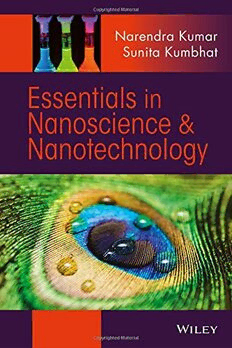Table Of Content(cid:2)
ESSENTIALS IN
NANOSCIENCE AND
NANOTECHNOLOGY
(cid:2) (cid:2)
(cid:2)
(cid:2)
(cid:2) (cid:2)
(cid:2)
(cid:2)
ESSENTIALS IN
NANOSCIENCE AND
NANOTECHNOLOGY
NARENDRAKUMAR
SUNITAKUMBHAT
(cid:2) (cid:2)
(cid:2)
(cid:2)
Copyright©2016byJohnWiley&Sons,Inc.Allrightsreserved
PublishedbyJohnWiley&Sons,Inc.,Hoboken,NewJersey
PublishedsimultaneouslyinCanada
Nopartofthispublicationmaybereproduced,storedinaretrievalsystem,ortransmittedinanyformor
byanymeans,electronic,mechanical,photocopying,recording,scanning,orotherwise,exceptas
permittedunderSection107or108ofthe1976UnitedStatesCopyrightAct,withouteithertheprior
writtenpermissionofthePublisher,orauthorizationthroughpaymentoftheappropriateper-copyfeeto
theCopyrightClearanceCenter,Inc.,222RosewoodDrive,Danvers,MA01923,(978)750-8400,fax
(978)750-4470,oronthewebatwww.copyright.com.RequeststothePublisherforpermissionshould
beaddressedtothePermissionsDepartment,JohnWiley&Sons,Inc.,111RiverStreet,Hoboken,NJ
07030,(201)748-6011,fax(201)748-6008,oronlineathttp://www.wiley.com/go/permissions.
LimitofLiability/DisclaimerofWarranty:Whilethepublisherandauthorhaveusedtheirbesteffortsin
preparingthisbook,theymakenorepresentationsorwarrantieswithrespecttotheaccuracyor
completenessofthecontentsofthisbookandspecificall disclaimanyimpliedwarrantiesof
merchantabilityorfitnes foraparticularpurpose.Nowarrantymaybecreatedorextendedbysales
representativesorwrittensalesmaterials.Theadviceandstrategiescontainedhereinmaynotbesuitable
foryoursituation.Youshouldconsultwithaprofessionalwhereappropriate.Neitherthepublishernor
authorshallbeliableforanylossofprofi oranyothercommercialdamages,includingbutnotlimitedto
special,incidental,consequential,orotherdamages.
(cid:2) (cid:2)
Forgeneralinformationonourotherproductsandservicesorfortechnicalsupport,pleasecontactour
CustomerCareDepartmentwithintheUnitedStatesat(800)762-2974,outsidetheUnitedStatesat
(317)572-3993orfax(317)572-4002.
Wileyalsopublishesitsbooksinavarietyofelectronicformats.Somecontentthatappearsinprintmay
notbeavailableinelectronicformats.FormoreinformationaboutWileyproducts,visitourwebsiteat
www.wiley.com.
LibraryofCongressCataloging-in-PublicationData:
Names:Kumar,Narendra(Materialsscientist),author.|Kumbhat,Sunita,
author.
Title:Essentialsinnanoscienceandnanotechnology/NarendraKumar,Sunita
Kumbhat.
Description:Hoboken,NewJersey:JohnWiley&Sons,Inc.2016.|Includes
bibliographicalreferencesandindex.
Identifiers LCCN2015040306|ISBN9781119096115(cloth)
Subjects:LCSH:Nanotechnology.|Nanoscience.
Classification LCCT174.7.K782016|DDC500–dc23LCrecordavailableat
http://lccn.loc.gov/2015040306
Typesetin10/12ptTimesLTStdbySPiGlobal,Chennai,India
10987654321
(cid:2)
(cid:2)
CONTENTS
Preface xiii
(cid:2) (cid:2)
Acknowledgments xv
AbouttheAuthors xvii
1 Introduction 1
1.1 Definition ofNanoscienceandNanotechnologies, 1
1.2 UniquenessoftheNanoscale, 3
1.3 NanoscienceinNature, 4
1.3.1 NaturallyOccurringNanomaterials, 7
1.3.2 NanoscienceinActioninBiologicalWorld, 8
1.4 HistoricalPerspective, 10
1.5 Nanomaterials, 13
1.5.1 Nanoparticles, 16
1.5.2 NanowiresandNanotubes, 17
1.5.3 Nanolayers/Nanocoatings, 17
1.5.4 NanoporousMaterials, 17
1.6 StrategiesforSynthesisofNanomaterials, 18
1.7 PropertiesofNanomaterials, 18
1.8 Significanc ofNanoscience, 19
1.9 CommercialApplications, 20
1.9.1 FoodIndustry, 22
1.9.2 Cosmetics, 22
1.9.3 Textile, 22
(cid:2)
(cid:2)
vi CONTENTS
1.9.4 Medicine, 22
1.9.5 ElectricalandElectronicGoods, 23
1.10 PotentialHealthHazardsandEnvironmentalRisks, 24
1.11 FuturisticOutlook, 25
ReviewQuestions, 26
References, 27
2 Nanomaterials:GeneralSyntheticApproaches 29
2.1 Introduction, 29
2.2 Top-DownApproach, 30
2.2.1 MechanicalMilling, 31
2.2.2 MechanochemicalProcessing(MCP), 32
2.2.3 Electro-Explosion, 33
2.2.4 Sputtering, 34
2.2.5 Etching, 34
2.2.6 LaserAblation, 36
2.2.7 Lithography, 37
2.2.8 Aerosol-BasedTechniques, 43
2.2.9 Electrospinning, 47
2.3 Bottom-UpApproaches, 49
2.3.1 ChemicalVaporDeposition, 49
(cid:2) 2.3.2 ChemicalVaporCondensation(CVC), 54 (cid:2)
2.3.3 PlasmaArcing, 55
2.3.4 WetChemicalMethods, 55
2.3.5 Hydrothermal/Solvothermal, 60
2.3.6 ReverseMicelleMethod, 60
2.3.7 Sol–GelMethod, 61
2.3.8 SonochemicalMethod, 64
2.3.9 BiomimeticApproaches, 66
2.3.10 MolecularSelf-Assembly, 70
2.3.11 Langmuir–Blodgett(LB)FilmFormation, 71
2.3.12 StabilizationandFunctionalizationofNanoparticles, 72
ReviewQuestions, 73
References, 74
3 CharacterizationToolsforNanomaterials 77
3.1 Introduction, 77
3.2 ImagingThroughElectronMicroscopy, 79
3.2.1 ScanningElectronMicroscope(SEM), 85
3.2.2 TransmissionElectronMicroscope(TEM), 91
3.3 ScanningProbeMicroscopy(SPM), 97
3.3.1 ScanningTunnelingMicroscope(STM), 97
3.3.2 AtomicForceMicroscope(AFM), 102
(cid:2)
(cid:2)
CONTENTS vii
3.4 CharacterizationThroughSpectroscopy, 107
3.4.1 UV–VisiblePlasmonAbsorptionandEmission, 108
3.4.2 VibrationalSpectroscopies:FTIRandRaman
Spectroscopy, 109
3.4.3 RamanSpectroscopyBasedImaging, 116
3.4.4 X-RayPhotoelectronSpectroscopy(XPS), 119
3.4.5 AugerElectronSpectroscopy, 126
3.4.6 SecondaryIonMassSpectrometry(SIMS), 130
3.5 ScatteringTechniques, 133
3.5.1 X-RayDiffractionMethods, 134
3.5.2 DynamicLightScattering(DLS), 140
3.5.3 ZetaPotentialAnalysis, 142
ReviewQuestions, 145
References, 146
4 Nanomaterials 149
4.1 Introduction, 149
4.2 InorganicNanomaterials, 150
4.2.1 MetalsandAlloys, 150
4.2.2 MetalOxidesofTransitionandNon-transitionElements, 156
4.2.3 Non-oxideInorganicNanomaterials, 161
(cid:2) 4.3 OrganicNanomaterials, 161 (cid:2)
4.3.1 PolymericNanoparticles, 161
4.3.2 PolymericNanofilms 162
4.3.3 Nanocellulose, 162
4.3.4 BiodegradablePolymerNanoparticles, 165
4.3.5 Dendrimers, 165
4.4 BiologicalNanomaterials, 166
4.4.1 Categories, 167
4.4.2 PotentialApplications, 169
4.5 NanoporousMaterials, 170
4.6 QuantumDots, 173
4.7 Nanoclusters, 175
4.8 NanomaterialsinDifferentConfigurations 178
4.8.1 Nanofibers 179
4.8.2 Nanowires, 179
4.8.3 Nanotubes, 180
4.8.4 Nanobelts, 183
4.8.5 Nanorods, 184
ReviewQuestions, 185
References, 186
(cid:2)
(cid:2)
viii CONTENTS
5 Carbon-BasedNanomaterials 189
5.1 GeneralIntroduction, 189
5.1.1 CarbonNanomaterials:SyntheticCarbonAllotropes
(SCAs), 190
5.2 Fullerene, 192
5.2.1 PropertiesofFullerene, 193
5.2.2 ApplicationPotentialsofFullerene, 195
5.3 CarbonNanotubes(CNTs), 196
5.3.1 Classificatio ofCNTs, 196
5.3.2 SynthesisofCNTs, 198
5.3.3 FunctionalizationofCNTs, 203
5.3.4 Purificatio ofCNTs, 205
5.3.5 SpecialPropertiesofCarbonNanotubes, 207
5.3.6 Applications, 208
5.4 Graphene, 208
5.4.1 ElectronicStructureofGraphene, 210
5.4.2 UniquePropertiesofGraphene, 211
5.4.3 Synthesis, 212
5.4.4 CharacterizationofGraphene, 219
5.4.5 Applications, 221
5.5 CarbonNano-Onions, 222
(cid:2) 5.6 CarbonNanofibers 224 (cid:2)
5.7 CarbonBlack, 225
5.7.1 Crystallinity, 227
5.7.2 HomogeneityandUniformity, 227
5.8 Nanodiamond, 227
5.8.1 SynthesisofNanodiamond, 228
5.8.2 Properties, 230
5.8.3 Applications, 232
ReviewQuestions, 233
References, 234
6 Self-AssembledandSupramolecularNanomaterials 237
6.1 Introduction:Self-Assembly, 237
6.1.1 SupramolecularChemistry, 238
6.2 HistoricalPerspectiveofSupramolecularandSelf-Assembled
Structures, 239
6.3 FundamentalAspectsofSupramolecularChemistry, 240
6.3.1 MolecularSelf-Assembly, 241
6.3.2 MolecularRecognitionandComplexation, 242
6.3.3 MechanicallyInterlockedMolecularArchitectures, 242
6.3.4 SupramolecularOrganicFrameworks(SOFs), 242
6.3.5 Biomimetic, 243
(cid:2)

